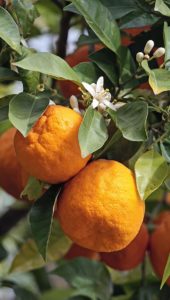
Find out more about the Sweet Orange plant of our Aromatherapy Herbarium blog series.

SWEET ORANGE
Citrus sinensis
DESCRIPTION

The orange tree (Citrus sinensis), is a fruit tree of the Rutaceae family native to Asia. It is the result of a natural hybridisation between grapefruit (Citrus maxima) and mandarin (Citrus reticulata).
ADVICE
As the essence of Citrus sinensis is phototoxic, avoid exposure to sunlight for twenty four hours after applying it. A skin test should be performed before using it for massages or beauty care as it is an irritant to some. Moreover, attention should be paid to certain drug interactions.
DO NOT USE IN
– pregnant or breast-feeding women,
– children under the age of three years,
– persons allergic to one of the components (geraniol, linalool, limonene),
– subjects with asthma without the advice of an allergologist before the first use,
– over a long period in persons with functional kidney failure (monoterpenes).
RECIPES
Anxiety
Take 1 drop of essence of sweet orange in one teaspoon of honey, or on a neutral tablet, three times per day for five days.
Cooking
3 to 5 drops of essence of sweet orange give flavour to flans, puddings, fruit salads and pastries and facilitate digestion.
Relaxation
Pour 10 drops of essence of sweet orange in a spoonful of powdered milk or neutral base for the bath in very hot water.
Insect stings
Apply 1 drop of pure essence of sweet orange onto the sting. Do not expose the skin to sunlight afterwards. In the event of exposure to sunlight, replace with 1 drop of essential oil of spike lavender.

Growing to a height of up to ten metres, it has spiny branches and leaves of four to ten centimetres. Its fruit – actually a berry – is called sweet orange to distinguish it from that of the bitter orange tree (Citrus aurantium).
Mignon sang “Do you know the country where the orange tree flowers?”. Talleyrand’s opinion of life under the Old Regime could be applied to orange, the fruit of happiness: he who ignores its flavour is ignorant of the gentle lifestyle. In Antiquity, the golden apples in the garden of the Hesperides were in fact oranges. Introduced to Europe by the Portuguese navigators returning from China – hence its Arabic and Greek names burtughal and portokali – sweet orange in German is a “Chinese apple” (Apfelsine). The glorious fruit overshadows the tree’s bark, that can be used to make an excellent aperitif, and the leaves, that Mattioli claimed to promote sweating to “eliminate all the nasty humours through the skin”. The fruit have been used to adorn countless chimneys, certifying the bride’s virginity.
CULTIVATION AND PRODUCTION
Orange trees are cultivated in hot regions such as the Mediterranean area, the Maghreb, China, South Africa and Australia. Introduced into California and Florida, the intensive production of the “Washington navel” species, developed in Brazil, has flooded the market. Brazil is by far the first orange juice exporter and the world turnover for the fruit, whose expansion has been stupendous, now reaches two billion dollars.
FRAGRANCE
The odour of sweet orange essence is light, fresh and fruity.
EXTRACTION AND YIELD
Cold expression of sweet orange peel (Citrus sinensis) gives a low yield of 0.2 to 0.4%, i.e. two to four hundred grams of essence from one hundred kilograms of plant. A deterpenated essence is used in the cosmetics industry.
CHEMICAL FORMULA
The main active constituents of essence of Citrus sinensis are monoterpenes (limonene: 92 to 97%), monoterpene alcohols (linalool), aldehydes and coumarins.
MAIN INDICATIONS
The soothing and sedative odour of sweet orange essence has a calming effect and ensures peaceful sleep. The full potential of its soothing effect is achieved when used in the bath. It re-balances the nervous system and relieves anxiety, agitation and palpitations. Stomachic and carminative, it has an anti-nausea effect and is an excellent digestive tonic. Cleansing when used in diffusion, it purifies and scents the ambient air while relieving tensions. When applied pure to the skin, it soothes wasp and bee stings and combats skin slackening.


Leave a Comment